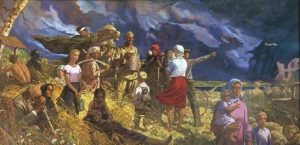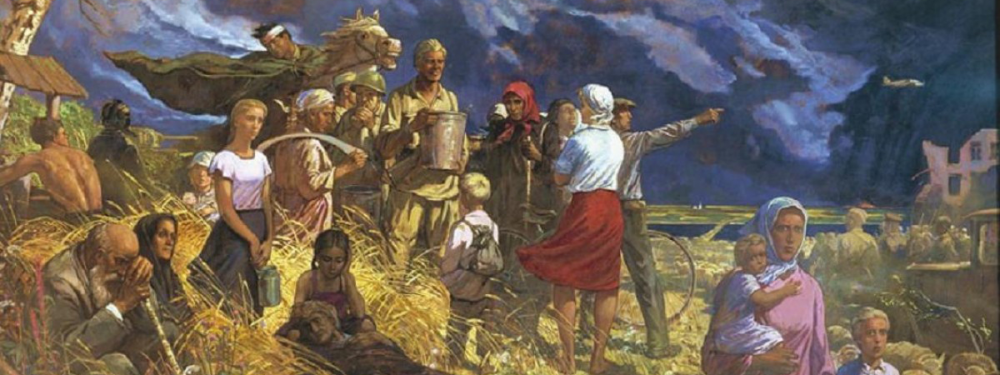When I set up this blog some time ago, I chose part of Ilya Glazunov’s painting The Roads of War as part of the banner at the top. The painting seemed to capture many of the things that I am interested in my research into the post-war reconstruction of the Soviet Union. The image shows us both the wartime experiences of both soldiers and civilians, but also men and women, children and the elderly. At the time it was a useful visual prompt for thinking about the war’s impact across society.

Ilya Sergeyevich Glazunov died on 9 July 2017, and as a result I’ve been prompted to return to thinking about Glazunov and this particular painting. Born in 1930, Glazunov was 87 years old, a survivor of the Siege of Leningrad and the Great Patriotic War. His life and artistic career mirrored Soviet and post-Soviet history in surprising ways. His own career enjoyed ups and downs which often shadowed wider political and cultural developments. His 1976 painting the Mystery of the Twentieth Century was so controversial that it the state may even have been considering deporting him. It is hard not to read his assignment to work on painting of labourers on the Baikal-Amur Railway (BAM) as a punishment.
The New York Times‘ obituary of Glazunov can be found here: https://www.nytimes.com/2017/07/12/arts/ilya-glazunov-painter-entranced-by-russias-past-dies-at-87.html
I’ve long been fascinated by Glazunov’s huge monumental works like Mystery of the Twentieth Century (1976) The Contribution of the People of the USSR to World Culture and Civilization (1980), Eternal Russia (1988), The Great Experiment (1990), and The Market of our Democracy (1999). All of these images strike me as statements about historical memory, and taken together they reveal much about how historical memory and official historical narratives shifted across the late Soviet to post Soviet periods. Difficult to read and interpret these images nevertheless attempt to say something powerful about the past. Glazunov was of course a very controversial artist. His painting were criticised by the Soviet state in the mid-1950s and early 1960s, but after the collapse of the Soviet Union he had a reputation as xenophobe and anti-Semite, and somebody with close links to the Kremlin.
This focus on memory in Glazunov’s work can clearly be traced back to The Roads of War, a painting informed by his own wartime experiences, the reception of which again reveals an enormous amount about historical memory, in this case – the challenges of remembering the Great Patriotic War.
Glazunov, who was eleven when the Wehrmacht invaded in June 1941 (b. 10/06/1930), old enough to understand the horror of what surrounded him. Trapped in besieged Leningrad he lost his mother, father, and other close relatives. It appears that his uncle facilitated his evacuation in 1942, now orphaned, to the village of Greblo in the Novgorod oblast’. The Roads of War is said to be informed by his childhood experiences, and perhaps we can read in it some of the wartime traumas which surely must have deeply shaken the young man. Returning to the city in 1944, he eventually enrolled at the I. E. Repin Institute of Painting, Sculpture and Architecture in 1951. It would be interesting to know much more about how Glazunov coped as an orphan in late Stalinist Leningrad, and how he occupied himself during these years. His graduation piece in 1957 was The Roads of War. The civilian and soldiers resting on the side of the road bathed in light on the left of the canvas, find themselves surrounded by darkened storm-filled sky, as well as darker signs of the impact of war, including military aircraft and wartime destruction.
This unglamorous and unheroic treatment of war was heavily criticised, and the painting was deemed so incendiary that it was removed from an exhibition in 1957 and destroyed. The version of the painting that we have today is recreation of the original work that Glazunov made in 1985. Forty years on from the end of the war, this in itself gives a hint in how the memory of the war was shifting.
